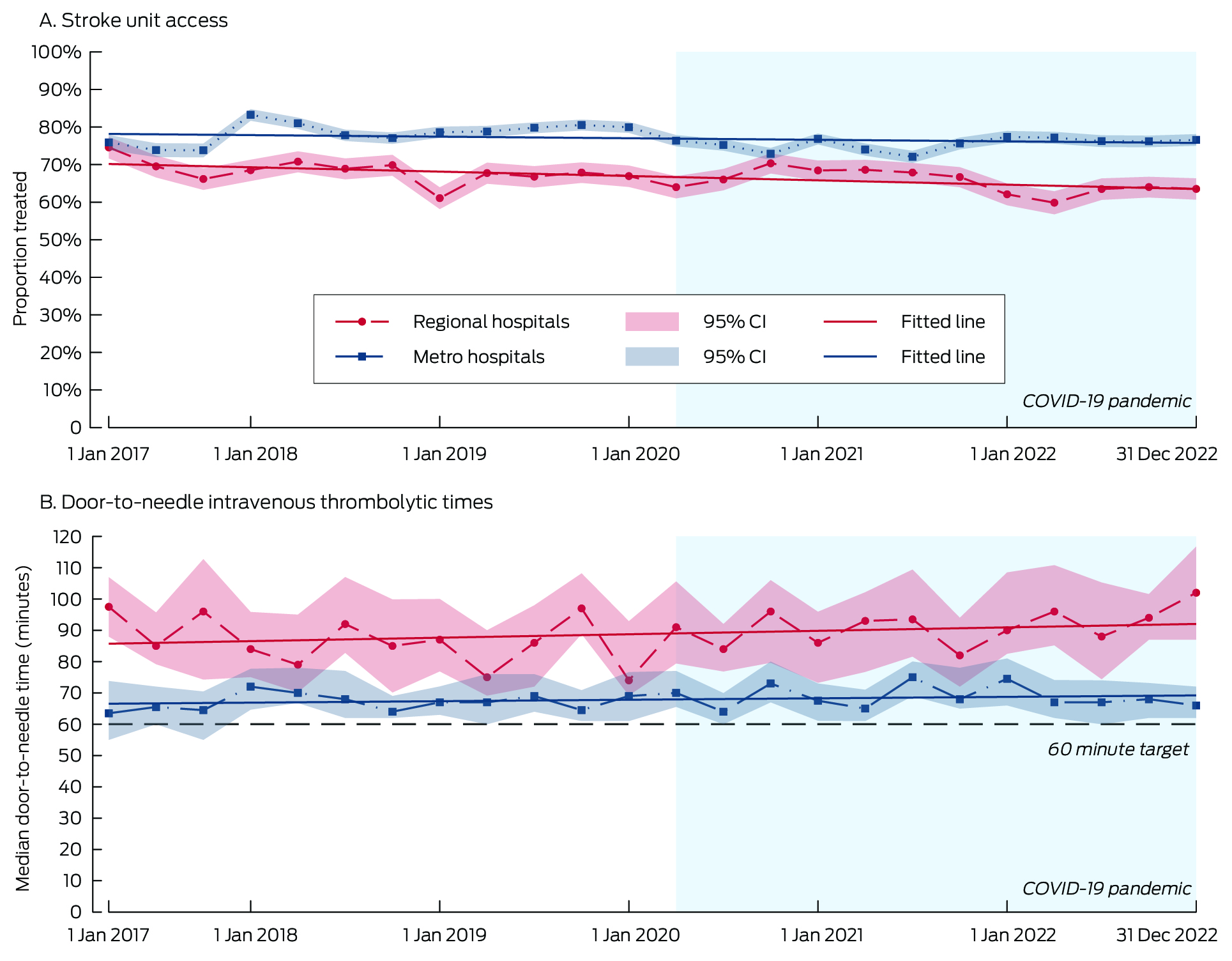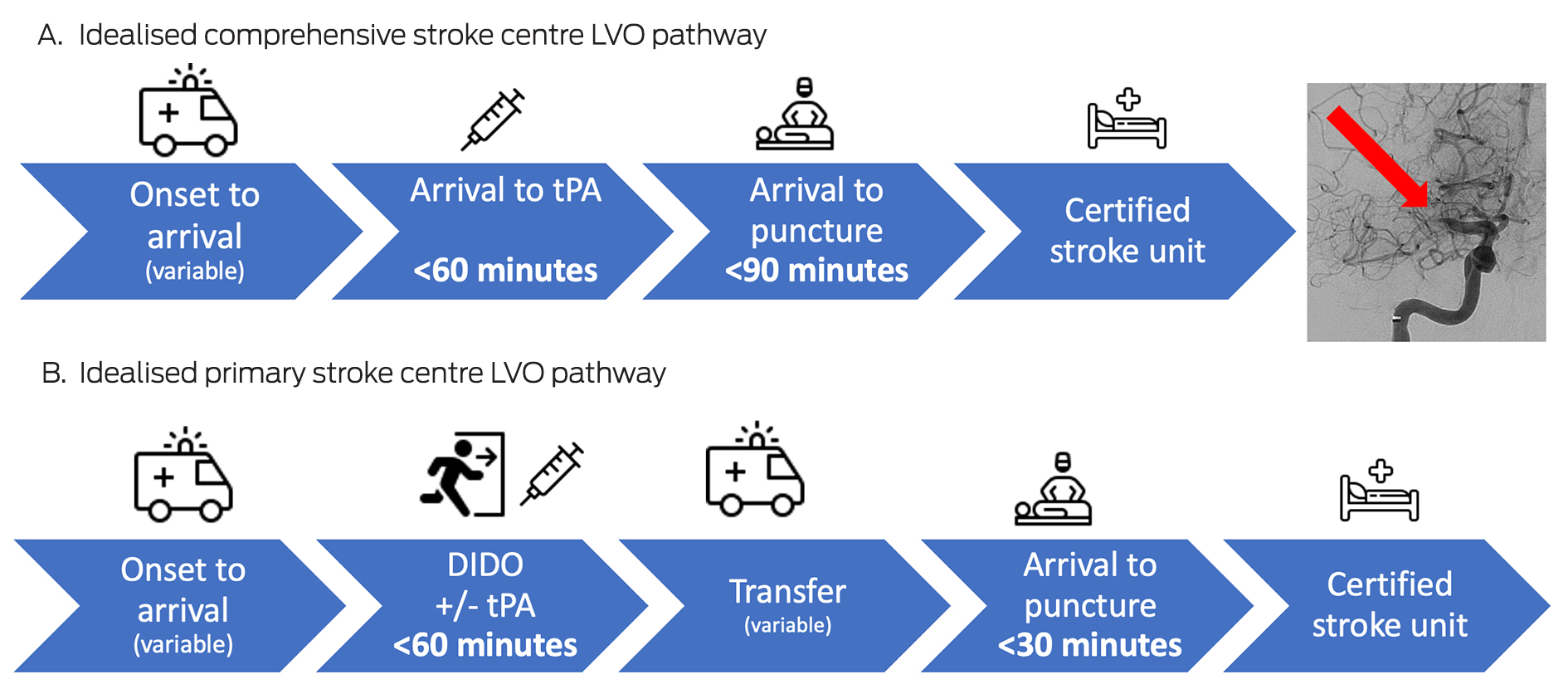Stroke is the world's second‐leading cause of death and the third‐leading cause of death and disability.1 In Australia, stroke is the third most common cause of death and a leading cause of disability.2 As a result, stroke is costly to the health system, society and the individual.3
Three acute stroke interventions have broadly applicable, significant, readily quantifiable health economic benefits: stroke unit care (for both ischaemic stroke and intracerebral haemorrhage)4 and ischaemic stroke reperfusion therapies, thrombolysis5 and endovascular thrombectomy (EVT).6 For every 17 patients treated in a stroke unit, one death or disabled outcome is prevented.4 The number needed to treat to prevent disability for thrombolysis under three hours is ten,5 and the EVT number needed to treat to prevent functional dependency is five.6 Expediting reperfusion therapies substantially magnifies treatment benefits; “saving a minute” gains an extra day of quality‐adjusted life following thrombolytic treatment,7 and an extra week following EVT.7,8
Australia's stroke performance languishes behind international peers
Despite Australia having a national acute stroke clinical care standard,9 a national stroke registry (www.auscr.com.au), several centres of excellence10 and population‐based reperfusion therapy rates comparable to other high income countries,11,12 Australia compares poorly internationally in stroke unit admission percentages and speed of reperfusion treatment.11 In 2022, Australia's median door‐to‐needle (thrombolytic) time was 75 minutes.11 Only 27% of patients were treated within an hour of hospital arrival, compared with 82% in Sweden,12 75% in the United States (US),13 and 61% in the United Kingdom (UK).14 In Sweden during 2022, 93% of patients with stroke were admitted to a stroke unit, compared with 75% in Australia. The US, from 2016 to 2019, reported median door‐arterial puncture times for non‐transferred EVT cases of 78 minutes15 versus 115 minutes in 2022 in Australia.11
Concerningly, door‐to‐needle times and stroke unit admission percentages have not improved over the past six years (Box 1). Regional and remote Australians are most significantly affected by these treatment gaps.11,16 Because a higher proportion of Aboriginal and Torres Strait Islander Australians live in non‐metropolitan areas, improving national stroke performance is a critical Closing the Gap initiative. Given the poorer stroke outcomes associated with suboptimal stroke care, continued national inertia is unjustifiable.
Box 1
National stroke registry evidence of flatlining stroke unit access rates and intravenous thrombolytic treatment times11
Genesis of the 30/60/90 national stroke targets
In 2023, national stroke leaders proposed that the “Championing Care”‐themed combined Smart Strokes/Australian and New Zealand Stroke Organisation annual conference should urgently tackle these shortcomings.
From February 2023, the largest and most harmful national performance gaps were identified, and improvement targets and timeframes were proposed (Supporting Information). Targets were iteratively developed from the Australian Commission on Safety and Quality in Health Care Acute Stroke Clinical Care Standard indicators9 against an informal matrix (Supporting Information, table 1), where the following criteria could be met:
- broad applicability: targets needed to apply to a significant proportion of patients with stroke;
- measurability: targets needed to be measurable within the current Australian stroke clinical registry;
- quantifiability: the health economic benefit of meeting targets needed to be quantifiable through robust estimates of the associated disability‐adjusted life year benefit; and
- improvability: targets needed to address areas of significant treatment variability, compared against high performing sites nationally and/or high performing nations internationally. Targets needed to be theoretically achievable by 2030.
Five clear standout areas for improvement were identified. Impactful targets reasonably achievable by 2030 were agreed, subsequently termed the “30/60/90 National Stroke Targets” (Box 2), incorporating certified stroke unit admission rates, rapid thrombolytic administration, rapid EVT, and rapid door‐in‐door‐out times for EVT‐eligible patients being transferred via road ambulance (Box 3). These targets were presented to a broad representative group at a pre‐conference workshop and unanimously endorsed by workshop attendees. The targets have since been ratified by every major Australian stroke‐interested organisation (Supporting Information).
Box 2
The 30/60/90 National Stroke Targets (Australia 2023)
Box 3
Idealised hyperacute large vessel occlusion (LVO) stroke pathways at comprehensive and primary stroke centres
During and following this workshop, we identified barriers to previous quality improvement efforts and facilitators for target progress (Box 4); many of which are counterparts. Key barriers included a previous lack of clearly articulated and prioritised targets and timeframes, lack of a national public‐facing competitive stroke data dashboard (as in the UK),14 our federated health system (with a complex mix of state and federal funding) and incomplete participation of hospitals nationally in transparent quality improvement initiatives. Facilitators include cohesive national stroke organisations, improving national telestroke coverage (both for acute and post‐acute care),17 a national stroke registry with recent development of national data dashboards, the recent national stroke unit certification initiative,18 recent refinement of the National Stroke System Framework19 and innovative pre‐hospital stroke technologies coordinated through the Australian Stroke Alliance.20
Box 4
Counterpart barriers to and facilitators for improving national stroke performance
We do not need to reinvent the key granular acute “code stroke” time‐saving strategies13,21 — many other countries have managed to improve their stroke care systems — we simply need to modify these proven strategies for the Australian context.
Key supporting initiatives
Most importantly, clinicians, health administrators and politicians need to commit to the key goals of stroke unit care for all, and expedited reperfusion treatment for eligible individuals. Three key initiatives need to then follow.
Stroke hospital mapping
All Australian hospitals should be identified as one of five potential stroke hospital categories, according to the 2023 Stroke Foundation National Acute Stroke Services Framework:19
- comprehensive stroke centre (CSC): a hospital providing 24/7 endovascular thrombectomy and neurosurgical services;
- primary stroke centre (PSC): a hospital providing 24/7 thrombolysis and stroke unit care;
- stroke capable regional general hospital (SCRGH): a hospital geographically distant from metropolitan centres, which provides 24/7 thrombolysis and stroke care approximating stroke unit care, but from which routine transfer to a large PSC or CSC is infeasible, due to distance;
- telestroke thrombolysis centre (TTC): a hospital providing telestroke‐enabled thrombolysis, ideally 24/7, but not providing stroke unit care;
- general hospital: a hospital that does not provide either thrombolysis or stroke unit care, but which should have protocols for patients presenting with stroke, to ensure rapid transfer to hospitals with thrombolysis and stroke unit care.
Ensuring access to stroke and stroke unit care, supported by stroke unit certification
Every person with stroke in Australia should be provided, where possible, with the opportunity to access both stroke unit care and reperfusion therapies, with the support of TTCs, general hospitals, ambulance services, retrieval services and telestroke capability. All current and potential CSCs, PSCs and SCRGHs should be supported by state and territory governments in meeting national stroke unit certification criteria and gaining certification, to ensure that optimal stroke unit care is being provided.
Implementing key reperfusion optimisation strategies at state and local levels
Each state stroke network (or equivalent) should identify state and hospital medical and stroke nursing leads to champion local strategies with proven impact. These strategies have been distilled in the 30/60/90 National Stroke Targets Action Plan, and include direct transfer of stroke patients from hospital arrival to the computed tomography (CT) room on the ambulance stretcher,10 using same‐crew and same‐stretcher transfer to a CSC if an EVT‐eligible large vessel occlusion stroke is identified.22 Thrombolytic agents should be administered as soon as the non‐contrast CT scan confirms eligibility in clear‐cut cases,23 and the EVT team contacted when large vessel occlusion is strongly suspected.23 Neuroimaging on arrival for transferred EVT cases should generally not be repeated, unless there have been protracted delays.24 And, perhaps most importantly, hospitals and stroke networks should acquire stroke metrics using standardised definitions, analyse results, be transparent about shortcomings, and plan improvements.21 It is acknowledged that smaller or more remote hospitals will be less able to reach national targets, and that larger well resourced centres will need to perform substantially better than the targets, to facilitate these national medians.
Monitoring national performance and fine‐tuning action plan strategies
The Australian Stroke Coalition will provide national support and will seek government or philanthropic support to adapt and optimise a “Get with the guidelines”, or similar, program.25 Approaches for funding will be grounded by a health economic analysis of benefits, should targets be met. State and national progress will be assessed at annual or biannual workshops, with lessons and strategies compared and shared. Performance will be incentivised by national achievement and improvement awards, and a national 30/60/90 stroke data dashboard through the national registry, where hospitals and states can compare their performance against their peers and the targets. It is hoped that national agreement on making the data dashboard consumer‐facing will be reached, to allow citizens with lived experience to also advocate for improvements.
Ancillary benefits
Reaching these targets is not an end, but a beginning. It is envisaged that the current targets will be Phase 1 of a sequence of national stroke targets. Achieving these targets will not only lead to improved stroke outcomes, but the streamlining and optimisation of acute stroke treatment pathways will greatly benefit Australian stroke professional training and research, across the continuum of stroke care. The mutual focus on a well articulated meaningful goal will increase team cohesion within hospitals, between professions, between states and between professional organisations.
Additionally, the optimised pre‐hospital pathways for acute stroke treatment will benefit the development of ultra‐early intracerebral haemorrhage pathways,26 and potentially pave the way for ultra‐early minimally invasive intracerebral haemorrhage surgery.27 Consumer‐facing national performance dashboards (if approved) may be adopted by other data‐driven specialties, such as cardiology (for acute coronary syndromes), trauma services and intensive care units. This target‐based, public‐facing, data‐driven approach, if broadly emulated, may serve as a key facilitator of nation‐wide “learning health systems”.28
Conclusion
A concerted effort is required to improve substandard Australian stroke unit admission rates and reperfusion treatment speed. A national commitment to addressing these treatment gaps is required, at all levels of health systems and government, supported by ambulance and retrieval services, emergency and radiology departments, and the medical and nursing staff administering acute stroke treatments. Addressing these shortcomings will provide a platform for further stroke improvements, and, if successful, could serve as a template for quality improvement initiatives in other health areas.
Provenance: Not commissioned; externally peer reviewed.








Open access:
Open access publishing facilitated by The University of Adelaide, as part of the Wiley ‐ The University of Adelaide agreement via the Council of Australian University Librarians.
Geoff Donnan and Stephen Davis for their helpful manuscript comments. Lachlan Dalli for assistance with the updated AuSCR data trends, and the hospital coordinators who have contributed data via the AuSCR.
No relevant disclosures for named authors. The Angels Initiative (a non‐promotional healthcare project of Boehringer Ingelheim International to improve stroke care around the world) provided support for the 2023 National Stroke Targets 30/60/90 workshop and logistical support surrounding this. The Angels Initiative is a member of the Australian Stroke Coalition taskforce. The Angels Initiative did not propose any target or amendment to any target, and had no input into this manuscript.